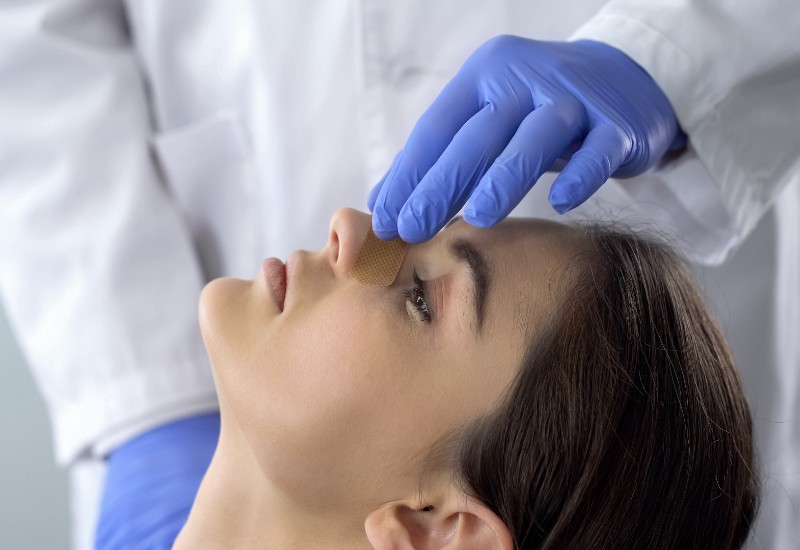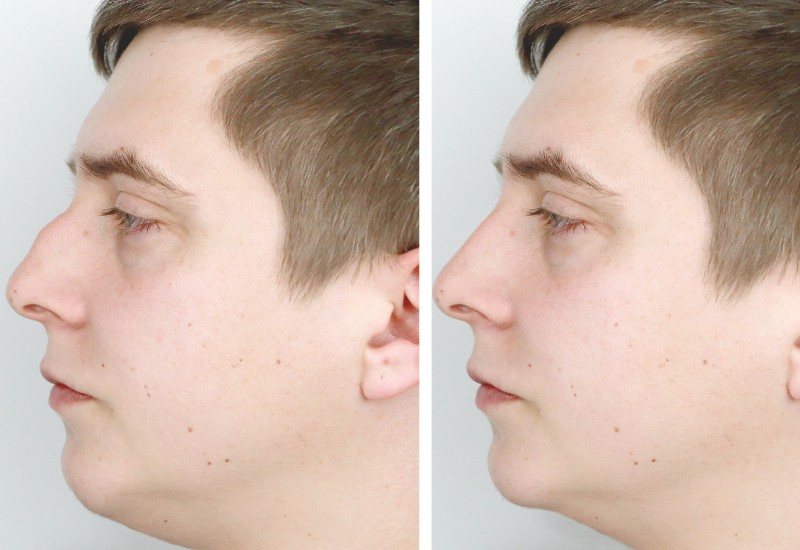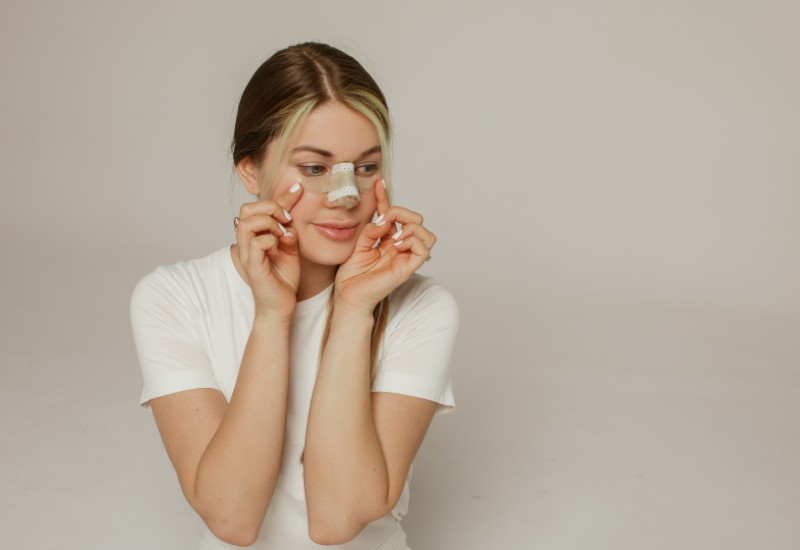If you are interested in changing the shape or size of your nose, you might want to consider rhinoplasty, also known as nose reshaping surgery. This procedure can help you achieve your aesthetic goals and address functional issues. At New Birkdale Clinic, rhinoplasty is one of our most popular procedures.
The data reveals a 102% rise in cosmetic procedures in 2022. Rhinoplasty has seen a 72% increase, making it the most popular cosmetic procedure among men. These statistics show the growing appetite for this particular type of nose surgery. In this article, we will look at what rhinoplasty entails in more detail, as well as its associated costs.
Let’s dive in.
What is Rhinoplasty?
Rhinoplasty, also known as a nose job or nasal rhinoplasty surgery, is a surgical procedure designed to change the shape of your nose. This nose reshaping technique can be performed for two primary reasons:
-
Aesthetic – To improve the balance of facial features and achieve your cosmetic goals.
-
Functional – If you struggle with breathing difficulties due to nasal obstruction or other issues you were either born with or developed.
Rhinoplasty involves reshaping the nasal bone, cartilage, or skin of the nose. In some cases, it may involve making alterations to all three structures to create your new nose.
Rhinoplasty Procedure
Rhinoplasty techniques can be broadly categorised into two main approaches:
Open Rhinoplasty Procedure
This technique involves making an incision across the columella, the tissue that separates the nostrils. This allows the cosmetic surgeon to lift the skin off the nasal structure and clearly view the underlying anatomy.

The open technique is often used for more complex cases requiring extensive reshaping or nasal reconstruction, or if the procedure is being carried out alongside other procedures, such as chin implants. It provides greater precision and control but results in a small, often barely visible scar on the columella.
Closed Rhinoplasty Procedure
Also known as endonasal rhinoplasty, this technique involves making all incisions within the nostrils, avoiding external scars. The surgical team works through these internal incisions to reshape the nose. This approach is generally used for less complex procedures and offers the advantage of reduced swelling and a shorter recovery time.
Types of Rhinoplasty
Here is a selection of other procedures used in rhinoplasty:
Tipplasty (Nose Tip Rhinoplasty)
This is a specialised type of nose reshaping surgery focused solely on reshaping the nasal tip. It often involves adjustments to the cartilage and is ideal if you’re unhappy with the proportion of the end of your nose in comparison to the rest of your facial features. Tipplasty can involve techniques such as:
-
Cartilage Removal – To reduce the size or width of the tip.
-
Cartilage Grafting – To add volume, enhance projection, or improve the shape.
-
Suturing Techniques – To refine and reposition the existing cartilage for better definition and symmetry.
Septoplasty
A septoplasty procedure involves straightening out the septum, which is the part of the nose that separates the two nostrils and is made from bone and cartilage. The septum is around 7cm long in adults. If you have a deviated septum, your nose can look crooked or bent, potentially blocking airflow and causing nasal congestion or breathing difficulties.
Revision Rhinoplasty
Revision rhinoplasty is a secondary procedure for patients dissatisfied with their initial nose surgery. It addresses both aesthetic concerns, such as over-correction, under-correction, or irregular shape, and functional issues, including breathing difficulties or complications from healing and trauma. This procedure is more complex due to scar tissue and altered nasal structure.

Non-Surgical Rhinoplasty
Non-surgical methods can be a great option for those who prefer less invasive techniques. The downside is that they have more limitations compared to their surgical counterparts.
For example, if you wanted to undergo nose reduction, non-surgical treatments wouldn’t be the best option. However, you could use injectable fillers to smooth out bumps and alter parts of your nose. Non-surgical options are temporary and best suited for minor adjustments.
What is the Rhinoplasty Procedure?
Here’s a step-by-step breakdown of the rhinoplasty procedure:
Consultation and Planning
The process begins with a consultation where our cosmetic surgeon evaluates your nasal structure, discusses your aesthetic goals, and reviews your medical history.
Digital imaging can be used to show what the outcome of your nose surgery might look like. After the consultation, our surgeon will create a surgical plan tailored to your specific needs and requirements to help you achieve the goals and aspirations for your new nose.
Preoperative Preparation
You’ll undergo a thorough medical evaluation, including blood tests and sometimes a nasal endoscopy. You’ll receive preoperative instructions, including which medications to avoid and guidelines on eating and drinking before surgery. This helps ensure the surgery goes as smoothly as possible and that you’re comfortable throughout.
What Happens During Surgery
If you decide to undergo a rhinoplasty procedure, this is what happens during surgery:
Anaesthesia
Rhinoplasty can be performed under general anaesthesia or local anaesthesia with sedation, depending on the complexity of the surgery and your preference. Our staff will carefully monitor your vital signs throughout the procedure, ensuring you’re under constant medical supervision.
Incisions
Incisions are made inside the nostrils, resulting in no visible scars. For open rhinoplasty, an additional small incision is made across the columella, allowing better access to the nasal structures and is often used for more complex cases or extensive nasal reconstruction.
Reshaping the Nose Structure
In a reduction rhinoplasty, our surgeon may remove bone or cartilage to reduce the size of the nose. In some cases, cartilage grafts (often from the septum or ear) are used for nose augmentation to enhance nasal structures. If you have a deviated septum causing breathing issues, your surgeon will straighten it and reduce projections inside the nose to improve airflow.

Closing the Incisions
The incisions are closed with sutures, which may be absorbable or need to be removed later. Internal tubes or splints may be placed inside the nose to support the septum. External splints or bandages are applied to maintain the new shape during healing.
Recovery
After surgery, you are monitored as you wake from anaesthesia. Sometimes, you can return home the same day, while others may require a short hospital stay. Regular follow-up visits are scheduled to monitor healing and remove any non-absorbable sutures and splints. Swelling and bruising are common and can take several weeks to subside. Final results may not be fully visible until a year after surgery.
Cost of Rhinoplasty in the UK
The cost of rhinoplasty in the UK can vary widely depending on several factors, such as:
-
The complexity of the procedure
-
The surgeon’s experience
-
The location of the private hospital or clinic
-
Whether it is being performed for cosmetic or medical reasons
Here is a look at the estimated costs of rhinoplasty surgery:
-
Primary Rhinoplasty – The cost for a primary rhinoplasty (first-time surgery) in the UK typically ranges from £4,000 to £7,000.
-
Revision Rhinoplasty – This can be more complex and expensive, ranging from £6,000 to £10,000.
-
Non-Surgical Rhinoplasty – A non-surgical rhinoplasty, which uses fillers to temporarily alter the shape of the nose, can cost between £300 and £800.
These procedures will usually require a deposit and may also offer instalment plans. For more information on rhinoplasty pricing, you can check out our facial surgery prices.
Reasons for Rhinoplasty
Some reasons why individuals choose to undergo Rhinoplasty include:
Cosmetic
If you are not confident with the shape or size of your nose, you might choose to undergo a rhinoplasty to improve your facial balance.
Functional
If you suffer from a deviated septum or other structural issues, you may undergo a rhinoplasty to correct breathing problems and make yourself more comfortable.
Reconstructive
Whether you have a congenital defect or you have sustained an injury on your nose, you may undergo rhinoplasty to address these issues.
Rhinoplasty Recovery
Nose surgery, or rhinoplasty, is performed under general anaesthesia and takes about two hours, usually followed by an overnight hospital stay. Dissolvable stitches seal the incisions and disappear within a week. Open rhinoplasty may leave some unnoticeable scarring, which your surgeon will discuss with you beforehand.
Bruising After Rhinoplasty
Recovery involves bruising and swelling of the nose, along with possible bruising around the eyes. Dressings inside your nostrils may prevent you from breathing through your nose for about a week, requiring mouth breathing during that time. A splint will be placed on your nose for support and must remain for at least a week.
Bruising typically starts to fade after two weeks, while it can take months for your nose to achieve its final shape. Common side effects include nasal congestion and light nosebleeds for about a week. Most patients take 7 to 10 days off work and should refrain from sports or heavy exercise for roughly six weeks. Keep these considerations in mind when planning your recovery.

Rhinoplasty at New Birkdale Clinic
Rhinoplasty is a relatively safe procedure that can give you amazing results, both from an aesthetic and functional point of view. We offer it here at New Birkdale Clinic.
Our cosmetic surgeons are among the most skilled in the world, and they have consistently delivered successful results for our rhinoplasty patients. Thanks to their innovative techniques, you can expect industry-leading results when choosing us for your nose reshaping surgery.
We pride ourselves on excellent patient care and strive to provide the best possible patient experience throughout your journey. Our surgical team is dedicated to helping you achieve your aesthetic goals while ensuring your comfort and safety.
Contact us if you want to know more about our rhinoplasty services and how we can help you achieve the nose you’ve always wanted.
Frequently Asked Questions
Some frequently asked questions concerning rhinoplasty include:
How painful is a rhinoplasty?
As patients report, rhinoplasty is not typically described as extremely painful. Like with any surgery, you are bound to experience some moderate discomfort during recovery. For the first week or so after the procedure, you will experience bruising and pain, but over-the-counter medication will help to improve this significantly.
How long does a rhinoplasty last?
Rhinoplasty is a permanent surgical procedure. Its results are typically meant to last a lifetime, although some gradual changes might happen over time due to normal ageing, affecting skin and soft tissues.
The results of your procedure will last a lifetime as long as you practice a healthy lifestyle and care for your skin.
Can I wear glasses after rhinoplasty?
It is recommended that you avoid wearing glasses immediately after your rhinoplasty procedure. Any pressure from your frames can impact the healing process and potentially warp the end results that you are trying to achieve. You should wait 4-6 weeks before resuming regular glasses use.
What’s the difference between a nose job and rhinoplasty?
Rhinoplasty is the medical term for a nose job, the procedure of changing the shape, size or structure of the nose.
